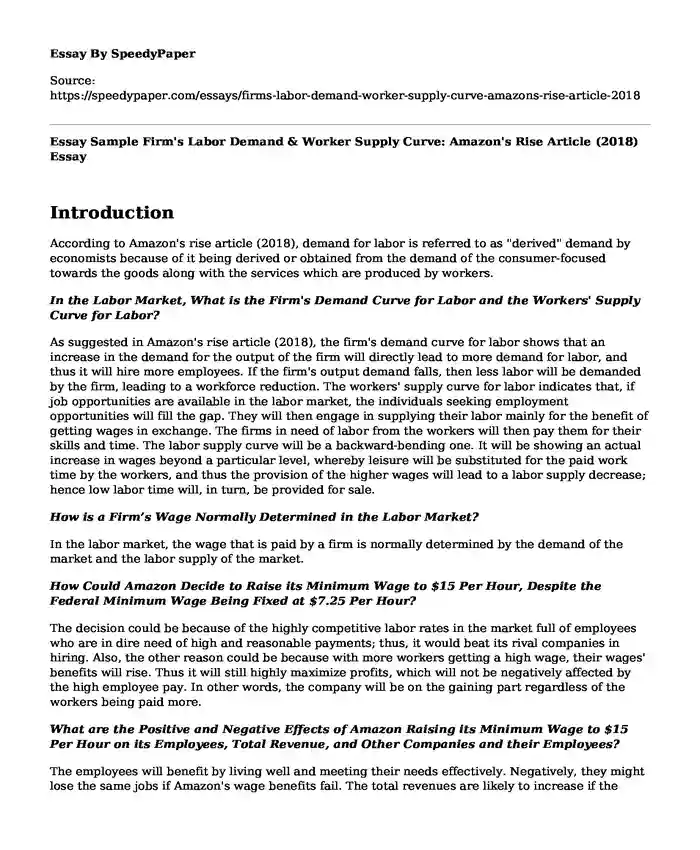
| Type of paper: | Essay |
| Categories: | Company Supply chain management |
| Pages: | 2 |
| Wordcount: | 523 words |
Introduction
According to Amazon's rise article (2018), demand for labor is referred to as "derived" demand by economists because of it being derived or obtained from the demand of the consumer-focused towards the goods along with the services which are produced by workers.
In the Labor Market, What is the Firm's Demand Curve for Labor and the Workers' Supply Curve for Labor?
As suggested in Amazon's rise article (2018), the firm's demand curve for labor shows that an increase in the demand for the output of the firm will directly lead to more demand for labor, and thus it will hire more employees. If the firm's output demand falls, then less labor will be demanded by the firm, leading to a workforce reduction. The workers' supply curve for labor indicates that, if job opportunities are available in the labor market, the individuals seeking employment opportunities will fill the gap. They will then engage in supplying their labor mainly for the benefit of getting wages in exchange. The firms in need of labor from the workers will then pay them for their skills and time. The labor supply curve will be a backward-bending one. It will be showing an actual increase in wages beyond a particular level, whereby leisure will be substituted for the paid work time by the workers, and thus the provision of the higher wages will lead to a labor supply decrease; hence low labor time will, in turn, be provided for sale.
How is a Firm’s Wage Normally Determined in the Labor Market?
In the labor market, the wage that is paid by a firm is normally determined by the demand of the market and the labor supply of the market.
How Could Amazon Decide to Raise its Minimum Wage to $15 Per Hour, Despite the Federal Minimum Wage Being Fixed at $7.25 Per Hour?
The decision could be because of the highly competitive labor rates in the market full of employees who are in dire need of high and reasonable payments; thus, it would beat its rival companies in hiring. Also, the other reason could be because with more workers getting a high wage, their wages' benefits will rise. Thus it will still highly maximize profits, which will not be negatively affected by the high employee pay. In other words, the company will be on the gaining part regardless of the workers being paid more.
What are the Positive and Negative Effects of Amazon Raising its Minimum Wage to $15 Per Hour on its Employees, Total Revenue, and Other Companies and their Employees?
The employees will benefit by living well and meeting their needs effectively. Negatively, they might lose the same jobs if Amazon's wage benefits fail. The total revenues are likely to increase if the other companies embrace the same rise and decrease if the move is not effectual. The other companies will face stiff competition, and thus they might be coerced in raising their wages too, leading to losses. The employees will be forced to leave the other companies to secure well-paying jobs in Amazon.
Reference
Amazon's raise: unequivocally good news. https://www.journalgazette.net/opinion/columns/20181007/amazons-raise-unequivocally-good-news. Retrieved on 23 May 2020.
Cite this page
Essay Sample Firm's Labor Demand & Worker Supply Curve: Amazon's Rise Article (2018). (2023, Aug 14). Retrieved from https://speedypaper.net/essays/firms-labor-demand-worker-supply-curve-amazons-rise-article-2018
Request Removal
If you are the original author of this essay and no longer wish to have it published on the SpeedyPaper website, please click below to request its removal:
- Corporation Reporting - Free Essay Example
- Free Essay. The Success in Attracting and Retaining Minorities at Pepsico
- Essay Sample on How to Identify and Resolve Conflict in Nursing
- Uber & Postmates Partner to Enhance Customers' Experiences - Essay Sample
- Essay Sample: Lawsuit Against Wells Fargo
- Free Essay Sample: Stakeholder Engagement in Project Management
- Essay on Navigating Challenges in Project Management: Forming Teams, Project Selection, and Successful Closeout
Popular categories




